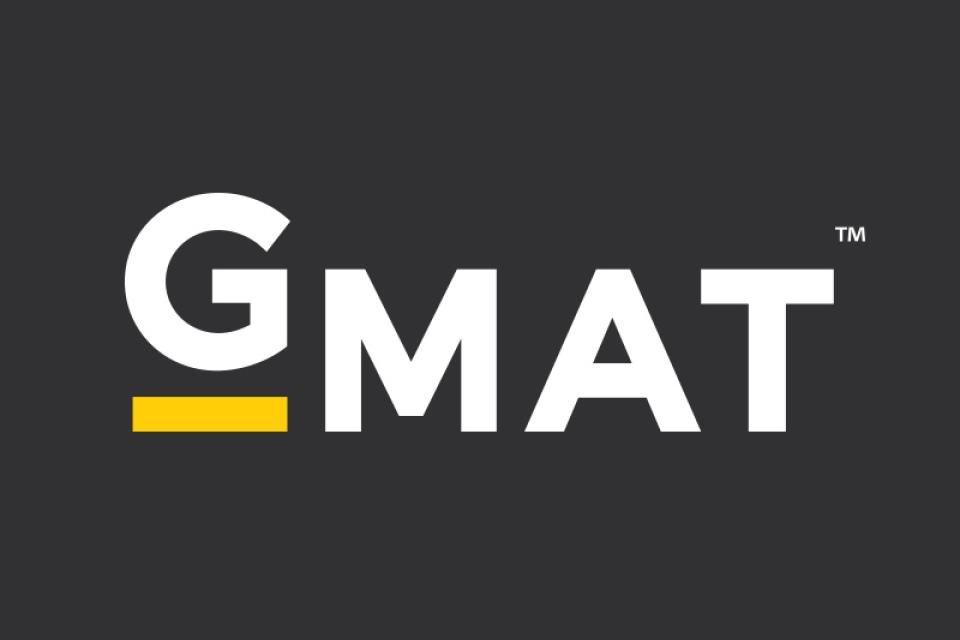Everything You Need to Know about the GMAT Exam
Guest blog by Kailin Burns, Senior Manager, Market Development, Americas GMAC (Graduate Management Admission Council)

(Editor's note: Kailin Burns, Senior Manager, Market Development, Americas at Graduate Management Admission Council presented in 2022.)
The GMAT exam is for those who are serious about business school. It was designed specifically with the business school admissions process in mind, and business schools use it to discover and select the right candidates. The GMAT Exam is accepted by over 7,700 business and management programs worldwide.
It’s also valuable for you, as a candidate, to demonstrate your commitment to business school, and it can be a key indicator of how you might perform in a program, which we'll discuss in a moment.
In addition, beyond business school admissions, the GMAT measures skills sought by employers, and some global organizations even use a GMAT score in hiring decisions.
Holistic Approach to Admissions
Keep in mind that when it comes to the admissions process, it's not only about your GMAT score. Admissions officers want to evaluate important intangibles and soft skills to get a complete and accurate picture of you.
This is why you submit other information in your application, such as your resume, essays, extracurricular activities, recommendations, and sometimes an interview with the program.
A school not only wants to make sure that you're both academically and personally a good fit for their program but also wants to ensure that you will benefit from the overall experience they offer. By taking a balanced approach and looking at all these different aspects, including your GMAT score, the admissions team can accomplish that goal.
Benefits of Taking the Exam
The GMAT exam is the most trusted and widely used assessment for business school admissions globally, and a key reason for this is that it is a strong predictor of academic success.
The GMAT has been around for 60 years. Regularly, GMAC conducts predictive validity research for specific schools to understand exactly how test scores correlate with the academic performance of MBA students. How do we do this? Well, we take GMAT section scores and total GMAT scores and compare those with course grades, year over year, for different academic programs.
What we've found is the results show that exam scores correlate with your business school GPA about halfway through the program. If you look specifically at the diagram shown here, you can see that when looking at the GMAT total score, this candidate’s score indicates that they would fall somewhere between a 3.2 and a 3.8 GPA, which is the first dark gray band.
When you factor in other things like the AWA and IR section scores and undergraduate GPA, we get a better sense of how this candidate might perform in the program. While additional factors help narrow down that GPA range, it’s the GMAT Total Score and section scores that are the strongest predictors of success.
GMAT Testing Center vs. Online
Next, let’s break down the GMAT Exam and look at the experience between taking the exam at a test center vs. taking it online.
As we look at the overall experience across the test center and online formats, we see that it is the same exam with different delivery methods.
The GMAT exam—whether delivered at a test center or online, serves the same purpose and skill sets, includes the same exam content, structure, and scoring methods, gives you control and flexibility for previewing and sending your scores, and, most importantly, the GMAT exam continues to uphold the integrity, trust, and credibility that it has maintained for over 60 years, regardless of delivery channel.
The two different delivery methods provide options for your test-taking experience: a structured setting in a test center or online in the comfort of your home. With that said, the check-in process, security protocols, and test administration will be different between the two formats. Taking the exam online is a permanent option, so the choice is yours on which format works best for you.
Similarities
Content and Structure
Looking at the content and structure, the GMAT exam, whether delivered at a test center or online, has four sections: Quantitative Reasoning, Verbal Reasoning, Integrated Reasoning, and Analytical Writing Assessment. The total time is roughly three hours and seven minutes, not including your two optional 8-minute breaks.
Registration
You can register for both exams at mba.com, and when it comes to how many times you can take the test, you have five attempts in a 12-month rolling period, and eight attempts total in your lifetime. You can take your attempts online, at a test center, or any combination.
Exam Cost
The exam cost is the same regardless of how you choose to test.
Score Scale
The score scale, scoring construct, and scoring methodology are all the same across both delivery methods.
You will get a score on a scale of 200 to 800 for the total score, 6 to 51 for the quantitative and verbal sections, 1 to 8 for the integrated reasoning section, and 0 to 6 for the analytical writing assessment.
Exam Sections
You will select the order in which you wish to take the exam. Some candidates like to start with a section they are more comfortable with to ease into the exam, while others prefer to get their harder subjects out of the way earlier. We encourage you to try different section orders throughout your preparation process, as the order you choose depends on your preference and how you prepare.
Scratchwork
One small difference is the materials you can use for scratchwork - at the test center, you will receive a laminated booklet and an erasable pen to use during the exam. If taking the test online, you have the option to use a physical whiteboard and an online whiteboard.
Getting Your Exam Scores
At the test center, you can preview your unofficial score at the end of the exam, and you’ll have to decide if you want to accept or cancel that score. You have the chance to select up to five free score reports before the exam, and if you accept your score, your official score report will automatically be sent to those programs. You can also send additional score reports after the exam for a fee.
For an exam delivered online, the score reporting process is slightly different. After you complete the exam, you'll be able to preview your unofficial score, but you do not need to accept or cancel the score. Once your official score is available via mba.com you have the flexibility to review your score and decide whether you would like to send that score to schools.
For both the exam delivered at a test center and online, your official score will be made available typically within seven business days. Regardless of your exam, your score is valid for five years.
Accommodations
There are accommodations available for both delivery methods, including extra time, extended breaks, and “comfort items” such as medical devices or medications you may need to access during the exam. For additional accommodations specific to the test center-delivered exam, you can visit mba.com, where you can also submit requests for accommodations.
Accommodations approvals will be sent via email with detailed information on the next steps. As a quick summary, for test centers, you will need to call to register for your exam and online, you will have a self-service registration option. Note that accommodations are approved at the candidate level and are valid for two years.
Next, we’ll look specifically at the registration process, the security protocols, and the score-sending experience for the exam delivered online, as well as a few commonly asked questions.
Fair and Secure Testing
A key tenant of the GMAT Exam is to ensure a fair and secure testing experience no matter the channel. For the exam delivered online, we’ve taken an integrated approach, implementing security tactics throughout the exam. In addition to the measures discussed previously that are applied before and during the exam, the team reviews the video recording of the session and conducts extensive post-exam forensics.
To support remote proctoring and bolster security, we leverage AI tools for ID authentication, ID matching and irregularity detection throughout the exam.
Manage Appointments
In your account, you can register for exams and manage your appointments. The pink box shows where your upcoming, scheduled exams will appear. To reschedule or cancel an appointment, you can click on the “Reschedule” or “Cancel” hyperlinks where the pink arrow is pointing.
The blue box shows where your past, completed exams will appear. Here you can see that this past appointment was canceled. If you have an appointment with a reportable score, you will see a “View Score” hyperlink which you can click to access your total and section scores and percentile rankings.
Appointments are available on a 6-month rolling basis, and there must be a 16-day gap between appointments. The reason for this is that we want you to take time between tests to review scores, rest, and plan for additional preparation if needed.
Note that there are a few locations where we cannot deliver the exam online due to regulatory restrictions, which are noted here.
Online Testing Experience
Seamless Check-in
Once you’re all registered and test day is approaching, there are some things you should do to ensure a smooth and seamless check-in experience.
- Review the ID requirements: Before your exam, it’s very important to review the ID requirements and confirm that the ID that you plan to bring on test day matches the one that you uploaded at registration.
- System and workspace requirements: Check and review ALL the system and workspace requirements. For example, your desk must be clear of all prohibited items, such as notebooks, papers, décor, and electronic devices. You must also run the system check and install the secure browser before test day. The direct links, download files, and the full list of system requirements and prohibited items can be found on mba.com.
- Test login: On test day, we recommend you log in at least 15 minutes early to check-in. As you go through the check-in process, you will need the security questions you entered during the registration and agree to the Test Taker Rules.
- ID validation and 360-degree room scan: After that, the remote proctor will validate your ID and complete a 360-degree room scan. You will be asked to show the front and back of your desk via your webcam and move the camera around the room or area to make confirm that there are not any prohibited materials in the area. Lastly, the proctor will have you open your task manager and close any applications or background tasks on your computer.
Once that whole check-in process is complete, the proctor will start the exam.
You will be required to keep the video feed on for the entire time, and you will need to show your blank physical whiteboard at the start of the exam before each break and at the end of the exam.
If you do have a question, of course, you have the option to raise your hand or type into the chat box to communicate with the proctor.
Get Your Scores
After you’ve completed the exam, you will be able to preview your unofficial score, and you will receive your official score typically within seven business days.
You can access and review your Official GMAT Online Score via your mba.com account and determine whether you would like to send your score to schools.
The GMAT exam delivered online includes up to five free score reports, which must be sent within 48 hours of receiving your Official Score, and scores are made available to the program within eight hours of submitting the score-sending request. You can send your Official Online Score to additional programs for a fee via mba.com.
Test Center Experience
We’ll dive deeper into the exam delivered at a test center.
Registration
You can register for a GMAT exam delivered at a test center by clicking the “Register” button via your mba.com account or throughout the website. Once you've completed your profile, you will be asked to choose your test center location. You can select up to three test center locations to check the appointment availability in your area and select which is most convenient for you.
Test centers are open seven days a week, and appointments vary by the test center operating hours.
Confirmation and Check-in Process
- In advance of test day, it is important to confirm the date, time, and location of the exam. Be sure to map your route and plan accordingly to avoid traffic or other delays.
- There is a list of items to bring and not bring on mba.com, so be sure to review that list in advance.
- You must store all personal items in a secure locker at the test center.
- Before the check-in process, please double-check that your ID complies with your local ID requirements and matches your registration information. Plan to arrive 30 minutes ahead of your scheduled appointment to allow for plenty of time for the check-in process.
- The test administrator will validate your ID, have you sign the Test Taker Rules, take a digital photo, and complete a palm-vein scan.
- Before the exam begins, you will be provided with five erasable note boards and an erasable pen, which must be returned at the end of the exam. The test administrator will start your exam, and if you need any help during the session, you can raise your hand for assistance.
- Note that there may be additional COVID-19 protocols that you must adhere to, depending on your test center location and local regulations.
Get Your Scores
The GMAT exam in a test center includes up to five free score reports. Before starting the exam questions, you will select up to 5 programs to receive your Official Score Report, so make sure to think about the schools you want to send your score to before test day
After you’ve completed the exam, you will see a preview of your unofficial score, and at that time, you will need to decide if you would like to accept or cancel your score. If you accept your score at the test center, you can still cancel up to 72 hours after your exam. If you cancel your score at the test center, you can reinstate it up to four years and 11 months later, within the five-year score validity period.
If you do accept your score, you'll receive a printout of your Unofficial Score Report at the test center, followed by your Official Score Report typically within seven business days. You can send your Official Score to additional programs for a fee via mba.com.
Prepare for the GMAT Exam
A question we often receive is: how much time should I spend preparing? Regardless of which delivery method you choose—test center or online—the exam structure, scoring, and content will be the same. Therefore, the preparation time will be the same.
Preparation Time and Impact on Scores
These two graphs show the median number of hours spent on preparation by score range and candidate location. For scores 700 or greater, candidates spend an average of 100 hours, and the number of hours reduces for lower score ranges. And you can see that candidates based in U.S. and Canada, on average, spend 50-70 hours, while in Asia and Europe, it’s closer to 100 hours.
However, there are other factors to consider when it comes to preparation time, so don’t take this as a firm guideline. Your discipline to study, your environment, the available time you have to commit to preparing for the exam, and your comfort level with the subject matter and question types are all important pieces to help you determine how much you need to study.
Another option to consider is whether you would like to participate in a preparation program. Many great test prep organizations can support you if you prefer a more structured program. Options range in topics, delivery modes, and class size, so you can find a program that best fits your preparation needs.
Prep for the Exam
We also offer several official GMAT prep products, including our official practice exams, the only exams that include actual questions from past exams. Our practice exams also use the exact same scoring algorithm and format as the real GMAT exam. A practice exam is a great way to set a baseline and identify your strengths and weaknesses to better focus your study efforts. On top of that, the practice exams allow you to practice your time management and pacing skills for test day.
The Official Starter Kit and Practice Exams 1 & 2 are free at mba.com.
We offer additional official products to help you prepare: Official Practice Questions 1 & 2, Official Practice Exams 3,4, 5 and 6, and of course, the GMAT Official Guide Series. Across the official guide bundle, there are over 2,000 GMAT questions from past exams, as well as verbal and quantitative review chapters that cover foundational concepts.
Test Day Best Practices
- First, plan your logistics in advance. If going to a test center, look up directions and map your route. If you’re taking the exam online, clear your workspace, check the system requirements, and download and install the secure browser. In both cases, arrive early and be sure to bring the appropriate required identification.
- While you’re taking the exam, read each question carefully and thoroughly. Determine exactly what's being asked, eliminate the wrong answers and select the best choice.
- Confirm your answer only when you are certain you want to move to the next question. You won’t be able to go back or change your answer after submitting it.
- Keep moving through the test. If you're stuck and can't figure out a question, choose the best answer and move on. You don't want to spend too much time on any single question.
- And to that point, keep your eye on the time. Again, this is why it’s important to practice your pacing. A clock is in the upper right-hand corner, so you check your time and progress.
- And finally, remember to relax before test day and on test day. Get a lot of sleep, keep your mind fresh, and feel confident that you've worked hard to prepare, and use that confidence going into test day.
Stay Connected with GMASS
As we wrap up the session, we wanted to share information on GMASS, our search service for recruiting. As a candidate, you can sign up to increase your exposure to school programs and learn more about the b-school experience and overall application process.
GMASS will also give you access to scholarship and financial aid information that schools provide directly through the GMASS system. 95% of our top 100 programs use the GMASS search service for recruiting, a critical tool for many schools.
Overall, GMASS can help you gain confidence by knowing that schools are interested in you before applying. This service is completely free to candidates, so I recommend checking it out at mba.com
We wish you the best of luck on your business school journey!




